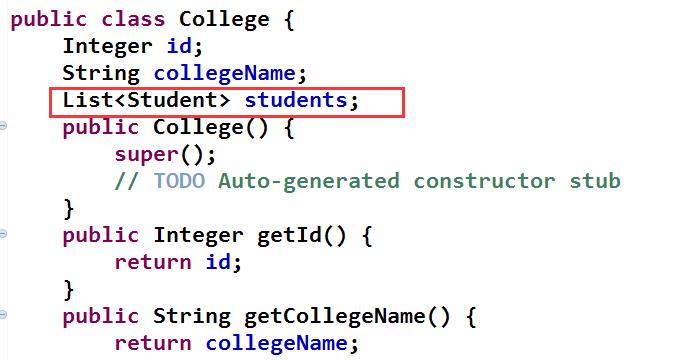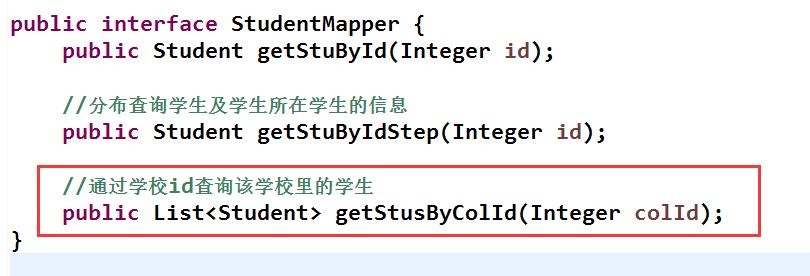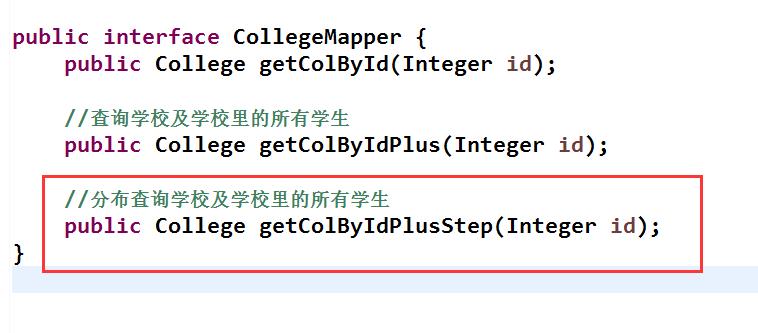13mybatis一对多resultMap中用collection指定集合的封装规则
Posted Arbitrary233
tags:
篇首语:本文由小常识网(cha138.com)小编为大家整理,主要介绍了13mybatis一对多resultMap中用collection指定集合的封装规则相关的知识,希望对你有一定的参考价值。
一、sql语句中使用左连接查询方式
一的一方College.java:

多的一方Student.java

College的mapper接口方法

College的sqlmapper文件配置
<resultMap type="com.pxxy.bean.College" id="collegeMap"> <id column="id" property="id"/> <result column="collegeName" property="collegeName"/> <!-- collection定义关联集合类型的属性的封装规则 property:指定属性中集合的名称 oftype:指定集合里面元素的类型;可以写别名--> <collection property="students" ofType="com.pxxy.bean.Student"> <id column="s_id" property="id"/> <result column="name" property="name"/> </collection> </resultMap> <!-- 左连接查询 --> <select id="getColByIdPlus" resultMap="collegeMap"> select c.id id,c.collegeName collegeName,s.id s_id,s.name name from college c left join student s on c.id = s.c_id where c.id=#{id} </select>
测试方法
//测试根据id查询学校以及学校的学生 @Test public void testGetColByIdPlus() throws IOException { String resource = "mybatis-config.xml"; InputStream inputStream = Resources.getResourceAsStream(resource); SqlSessionFactory sqlSessionFactory = new SqlSessionFactoryBuilder().build(inputStream); SqlSession sqlSession = sqlSessionFactory.openSession(); CollegeMapper collegeMapper = sqlSession.getMapper(CollegeMapper.class); College college = collegeMapper.getColByIdPlus(1); System.out.println(college); for(Student stu:college.getStudents()) { System.out.println(stu); } sqlSession.close(); }
结果:

二、分布查询方式
一的一方College.java:

多的一方Student.java

StudentMapper接口定义根据学校id(c_id)查询所在该学校的学生方法

StudentMapper的sql配置文件进行配置与接口方法相对应
<select id="getStusByColId" resultType="student"> <!-- 列名和属性名相同不用起别名 --> select * from student where c_id=#{colId} </select>
CollegeMapper接口中定义分布查询学校及学校里的所有学生的方法

CollegeMapper的sql配置文件进行配置与接口方法相对应
<resultMap type="com.pxxy.bean.College" id="collegeStepMap"> <id column="id" property="id"/> <result column="collegeName" property="collegeName"/> <!-- property="":指定哪个属性是联合的对象 select:表面当前属性是调用select指定的方法查出的结果 column:指定将哪一列的值传给这个方法作为参数 流程:使用select指定的方法(传入column指定的值作为参数)查出对象,并封装给property指定的属性 --> <collection property="students" select="com.pxxy.bean.StudentMapper.getStusByColId" column="id">
</collection> </resultMap> <!-- 分布查询学校及学校里的学生 --> <select id="getColByIdPlusStep" resultMap="collegeStepMap"> select * from college where id = #{id} </select>
测试方法
//测试根据学校id分布查询学校以及学校的学生 @Test public void testGetColByIdPlusStep() throws IOException { String resource = "mybatis-config.xml"; InputStream inputStream = Resources.getResourceAsStream(resource); SqlSessionFactory sqlSessionFactory = new SqlSessionFactoryBuilder().build(inputStream); SqlSession sqlSession = sqlSessionFactory.openSession(); CollegeMapper collegeMapper = sqlSession.getMapper(CollegeMapper.class); College college = collegeMapper.getColByIdPlusStep(1); System.out.println(college.getCollegeName()); for(Student stu:college.getStudents()) { System.out.println(stu); } sqlSession.close(); }
测试结果

可以看出这里也使用了延迟加载,因为在mybatis的全局配置中配置了延迟加载

以上是关于13mybatis一对多resultMap中用collection指定集合的封装规则的主要内容,如果未能解决你的问题,请参考以下文章